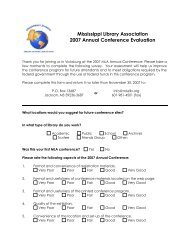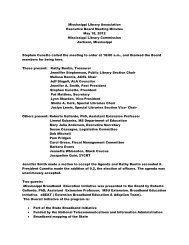Full Text (PDF) - Mississippi Library Association
Full Text (PDF) - Mississippi Library Association
Full Text (PDF) - Mississippi Library Association
You also want an ePaper? Increase the reach of your titles
YUMPU automatically turns print PDFs into web optimized ePapers that Google loves.
<strong>Mississippi</strong> Libraries Vol. 75, No. 1, Spring 2012 Page 19<br />
of the University of Southern <strong>Mississippi</strong><br />
provides the first phase results of a twophase<br />
study analyzing “public school<br />
libraries in <strong>Mississippi</strong>, their impact on<br />
academic achievement, and how the perceptions<br />
of teachers, principals and librarians<br />
shape the function and use of those<br />
libraries” (2003, p. 97-98). Modifying a<br />
survey instrument developed by researcher<br />
Lance to include items relevant to the <strong>Mississippi</strong><br />
educational system, Roberson et<br />
al. collected data on practices in libraries of<br />
low and high performing schools. The<br />
schools were categorized based on the<br />
accreditation level of their school districts<br />
as assigned by the State of <strong>Mississippi</strong> –<br />
districts with accreditation levels of three,<br />
four, or five were categorized as successful<br />
while level one or two districts were categorized<br />
as unsuccessful (Roberson et al.<br />
2003, p. 104). The authors categorized<br />
the differences between libraries in successful<br />
versus unsuccessful schools into<br />
five areas: collections, budget, library use,<br />
technology, and staffing (Roberson et al.<br />
2003, p. 105) and found that:<br />
The successful schools in the present<br />
sample had more print volumes,<br />
more magazine subscriptions, more<br />
electronic subscriptions, more video<br />
materials, more reference titles on<br />
CD-ROM, and more student software<br />
packages available for student<br />
use. In 2002, libraries in samples of<br />
successful schools were allocated<br />
43% more money than was allocated<br />
for library expenditure in the<br />
unsuccessful schools…successful<br />
schools had more than twice the<br />
number of computers in their<br />
libraries; 14 compared to 5.27…<br />
more than twice as many computers<br />
[in successful schools] as opposed<br />
to the unsuccessful schools were<br />
Internet connected or connected to a<br />
printer. The implication is that in<br />
successful schools students have<br />
greater access to electronic research<br />
tools in their school library (Roberson<br />
et al. 2003, p. 105).<br />
The study further indicated that, “successful<br />
schools schedule more class time<br />
in the library, spend more time allowing<br />
students to check out materials, have more<br />
individual student research hours, offer<br />
more time for reading incentive programs<br />
like Accelerated Reader, are used more by<br />
faculty members for professional growth<br />
and classroom support, and are open<br />
more hours beyond the school day”<br />
(Roberson et al. 2003, p. 105). Successful<br />
school library media specialists reported<br />
more time spent collaborating with the<br />
school principal and teaching staff, facilitating<br />
staff development, and providing reading<br />
incentives (Roberson et al. 2003, p.<br />
105).<br />
Taking into consideration the above referenced<br />
studies, this researcher concludes<br />
that the four characteristics that most effectively<br />
strengthen the link between library<br />
media centers and the academic success of<br />
students are as follows:<br />
A professional, credentialed media specialist<br />
capable of promoting information<br />
literacy, training in technology applications,<br />
teaching reading skills, and<br />
extending library hours of operations to<br />
accommodate more students<br />
Administrators who understand the<br />
value of library services and allocate<br />
resources to the development of<br />
libraries<br />
A teaching staff that willingly collaborates<br />
with the library media specialist<br />
during the instructional planning<br />
process and understands, promotes and<br />
utilizes the resources and services<br />
offered by the library media center<br />
Funding adequate to cover the implementation<br />
of library development initiatives,<br />
the hiring of support staff, the<br />
expansion and maintenance of the<br />
school’s computer network, the acquisition<br />
of computer hardware and software,<br />
and the purchase of high quality<br />
periodicals, books and other resource<br />
materials throughout the school year<br />
that support the needs of students and<br />
teachers<br />
Training for School Administrators<br />
In a study conducted by Roberson,<br />
Schweinle, and Applin of the University of<br />
Southern <strong>Mississippi</strong> titled, School<br />
Libraries’ Impact Upon Student Achievement<br />
and School Professionals’ Attitude<br />
That Influence Use of <strong>Library</strong> Programs,<br />
the authors point to a “gap that exists<br />
between what is known about the positive<br />
student outcomes that can be realized by<br />
use of quality library programs and the attitudes<br />
about such programs held by principals,<br />
teachers, and librarians” (Roberson et<br />
al. 2005, p. 51). The authors also found<br />
that teachers were “significantly less<br />
amenable to cooperation with librarians in<br />
instructional unit development” (Roberson<br />
et al. 2005, p. 48), and reported that<br />
“librarians should spend more time with<br />
students rather than working cooperatively<br />
with teachers in instructional design and<br />
implementation” (Roberson et al. 2005, p.<br />
50). The study results indicated that “the<br />
more positively a teacher or principal felt<br />
about librarians, the more positive their<br />
attitudes were regarding working cooperatively<br />
with the librarian in instructional<br />
activities” and that “teachers’ present positive<br />
attitudes towards librarians developed<br />
from academic training and experiences<br />
within the school setting” (Roberson et al.<br />
2005, p. 50). Teachers and principals<br />
indicated a dearth of lessons, courses, and<br />
seminars offered in their degree programs<br />
that emphasize the value of library media<br />
centers and the effective utilization of<br />
school library resources to aid in instruction.<br />
As stated by the authors, a need exists<br />
“for curricular reform and alignment in<br />
higher education to develop and advance<br />
attitudes and practices…towards cooperative<br />
work among teachers and librarians<br />
and an improved utilization of school<br />
libraries to maximize student learning”<br />
(Roberson et al. 2005, p. 52).<br />
In another study by Roberson,<br />
Schweinle, and Applin titled, Survey of the<br />
Influence of <strong>Mississippi</strong> School <strong>Library</strong><br />
Programs on Academic Achievement:<br />
Implications for Administrator Preparation<br />
Programs, the authors found that<br />
“many administrators and classroom<br />
teachers still hold a stereotype of libraries<br />
as disposable” (Roberson et al. 2003, p.<br />
99) and that articles in professional publications<br />
and personal school experiences<br />
are the basis from which principals, teachers,<br />
and higher education faculty form their<br />
views of school library programs. According<br />
to Roberson et al., journal articles concerning<br />
school libraries are rarely published<br />
in the professional and scholarly














